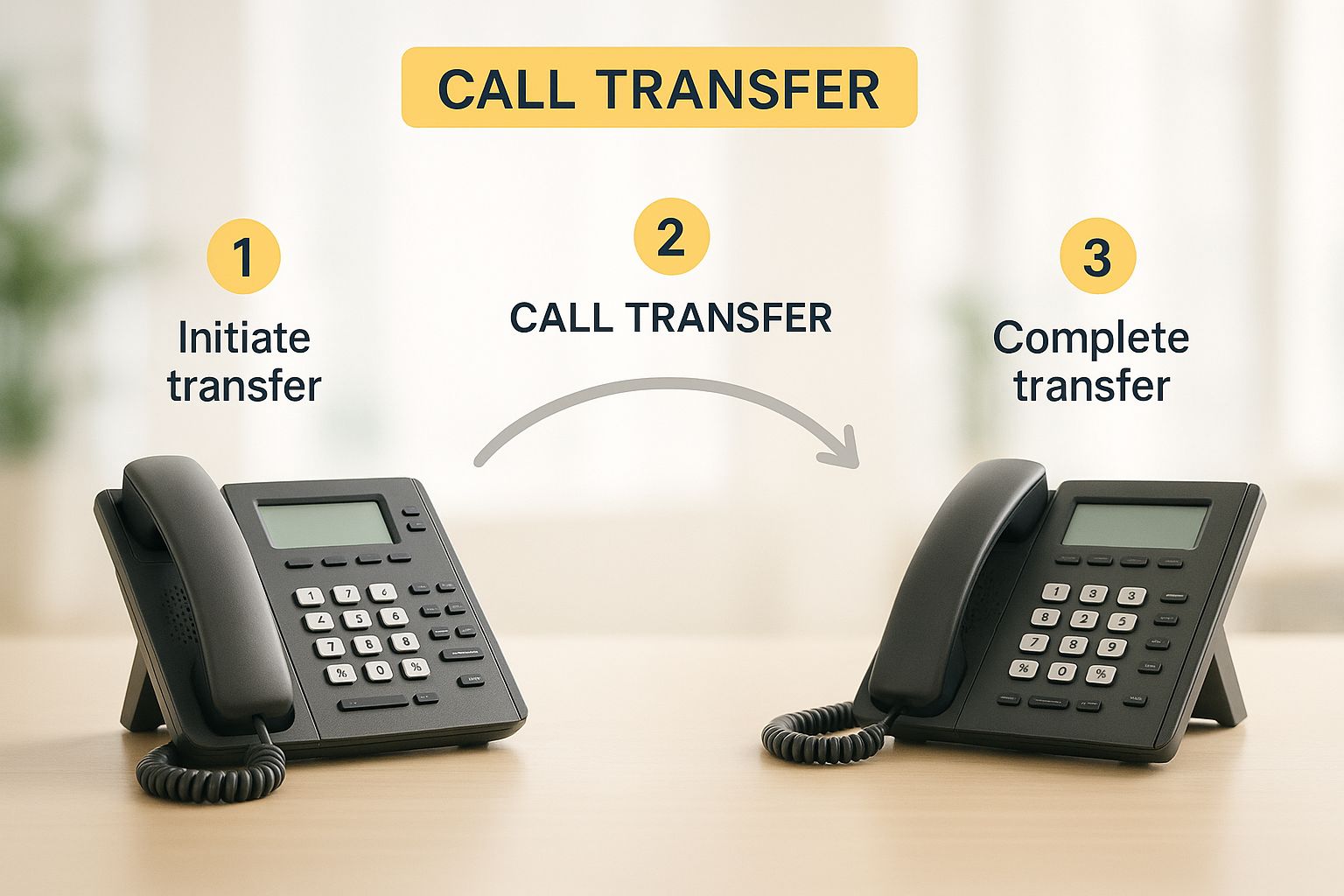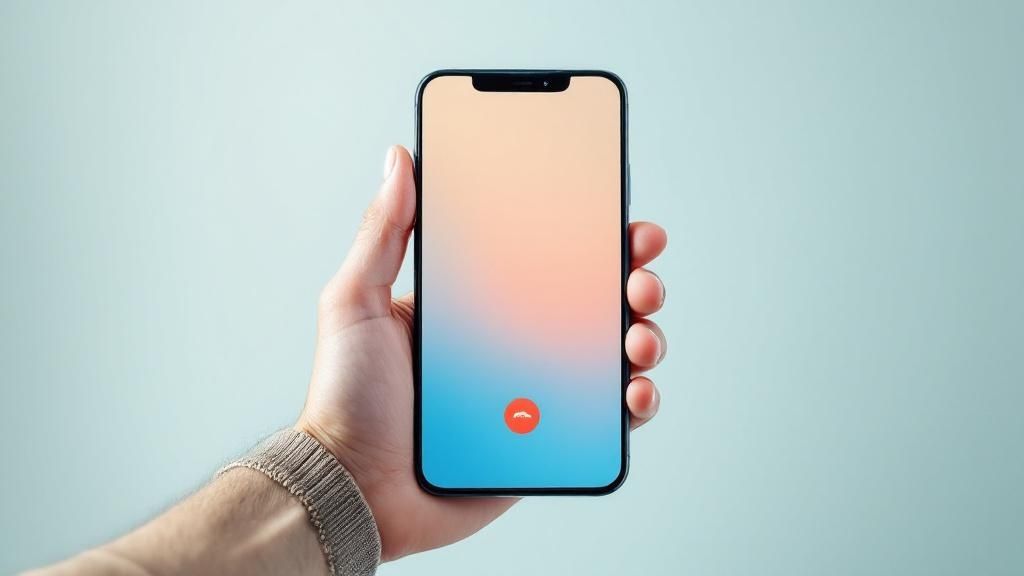Fumbling a call handover is a surefire way to frustrate a customer and leave your team scrambling. The real secret to knowing how to transfer calls like a professional is all about picking the right method for the situation. It usually comes down to two choices: a warm transfer (where you announce the call) or a cold transfer (where you send it straight through). Getting this right isn’t just a small detail; it’s a cornerstone of running an efficient operation and delivering exceptional service.
Mastering the Art of the Seamless Call Transfer
Learning how to transfer calls is more than just knowing which buttons to press. It's a critical communication skill that has a direct impact on how customers see your business and how smoothly things run internally. A poorly handled transfer can instantly sour an experience, forcing customers to repeat themselves and making your whole organisation look disorganised.
On the other hand, when you nail it, you look polished, professional, and completely on top of things.
The two main methods you'll be working with are warm and cold transfers. The easiest way to think about them is as two different tools for two very different jobs.
Warm vs. Cold Transfers
A warm transfer, which is sometimes called an attended transfer, is what I’d consider the gold standard for customer service. This is where you actually speak to your colleague first. You'll give them the caller's name and a quick rundown of what they need before you connect the two. It makes for a truly seamless handover where the customer doesn't have to start their story all over again.
Then you have the cold transfer, also known as a blind transfer. This one's much simpler: you just send the call directly to the new line without any introduction. It’s best to save this for really straightforward situations, like transferring someone to a general department voicemail or a public info line where no one needs any prior context.
The choice between a warm and cold transfer is more than a procedural step—it's a reflection of your customer service philosophy. A warm transfer says, "We value your time and are handling your issue with care."
This image gives you a basic idea of how a business call transfer flows.

As you can see, it's all about creating a smooth, direct connection to move a conversation from one person to another. The impact of getting this wrong is pretty significant. Research shows that in Australian contact centres, improper call transfer management can slash customer satisfaction by as much as 12% and drop first-call resolution rates by 14%. You can read the full research about these findings to see just how vital this process really is.
Warm Transfer vs Cold Transfer At a Glance
Still not sure which one to use? Choosing the right transfer method really depends on the customer's situation. A warm transfer is personal and great for complex issues, while a cold transfer is quick and efficient for simple requests.
This table breaks down the key differences to help you decide on the fly.
| Feature | Warm Transfer (Attended) | Cold Transfer (Blind) |
|---|---|---|
| Process | Agent speaks to the recipient first to provide context before connecting the caller. | Caller is transferred directly to the new line or agent with no prior introduction. |
| Customer Experience | High. The customer feels valued and doesn't need to repeat their issue. | Can be low if context is needed. The customer might feel passed around. |
| When to Use | Complex issues, escalations, first-time callers, or when personal service is required. | Simple queries, transferring to a general queue/department, or when the caller requests it. |
| Agent Time | Takes slightly longer as it involves an extra conversation. | Very fast. The transfer happens instantly with a few clicks. |
| Best For | Building rapport and ensuring first-call resolution. | High-volume call environments where speed is essential for basic routing. |
Ultimately, training your team on when and how to use each type of transfer is key. A well-placed warm transfer can turn a frustrated customer into a loyal one, while a swift cold transfer keeps things moving efficiently when a deep-dive isn't needed.
Let's be honest, a smooth call transfer is more than just good phone etiquette—it's a smart business move that has a real impact on your operations and, ultimately, your profitability.
When you nail how to transfer calls, you're not just passing on a conversation. You're protecting two of your most valuable assets: your team's time and your customer's patience. Every single minute someone spends on a misdirected call is a minute they could have spent on something productive.
Getting a caller to the right person on the first try does more than just solve their problem. It tightens up your internal processes, cuts down on staff frustration, and gives your whole team's efficiency a boost. Think of it like fixing a small leak before it turns into a burst pipe; a clean handover stops a small issue from becoming a massive headache.
Creating a Better Customer Experience and Building Loyalty
Beyond just making things run smoother internally, a seamless transfer is a massive win for customer retention. Every single interaction is a chance to show your customers that your brand is competent and genuinely cares.
A caller who gets transferred without a fuss feels heard and valued. It can turn a routine question into a surprisingly positive experience with your brand, which is a huge deal in a competitive market.
In a world where customers have endless choices, the quality of your service is what sets you apart. A perfect call transfer shows you respect their time and intelligence, building the kind of trust that creates long-term loyalty.
The Australian call centre industry, which is tipped to be worth around $2 billion by 2025, is built on this very idea. Customer service and retention are the biggest slices of this massive pie, highlighting just how crucial flawless call handling is for solving issues quickly and keeping customers on side. You can discover more insights about the Australian call centre industry to see the sheer scale of it all.
The Direct Link to Your Bottom Line
At the end of the day, all these benefits feed directly into your bottom line. Happy, loyal customers don't just stick around; they tell their mates about you. At the same time, a more productive team can handle more work without getting burnt out, which helps keep operational costs down and maximises what you can get done.
It really breaks down like this:
- Improved Retention: Great service gives customers zero reason to look at your competitors.
- Increased Efficiency: Wasting less time on repeat calls means more time for activities that actually make money.
- Stronger Reputation: Good word-of-mouth from positive service experiences is the best kind of marketing.
By mastering the art of the call transfer, you're not just learning a small skill. You're investing in a more resilient, reputable, and profitable business. It’s a small detail with a massive impact.
Right, so you know the difference between a warm and a cold transfer. But putting that theory into practice on the device you're actually holding? That's where the rubber meets the road.
While the exact buttons and menu names might vary a little, the basic steps for transferring a call are pretty much the same across most modern phone systems.
Let's walk through how to handle this on the gear your team is probably using right now.

Transferring on a Traditional PBX or VoIP Desk Phone
For a lot of us in office-based roles, the good old desk phone is still the main hub. Whether it's a classic PBX system or a newer VoIP phone, the whole process usually revolves around a dedicated Transfer button.
Picture this: a sales call comes in, but the customer is asking about a completely different product line. For a warm transfer, here’s what you’d typically do:
- While you’re on the call, hit the Transfer or "XFER" button. This puts the caller on a temporary hold.
- Dial your colleague's extension or direct number.
- When they pick up, give them a quick heads-up. Something like, "Hey Sarah, I've got David on the line asking about the new software package."
- Once she gives you the green light, just press the Transfer button one more time to connect them, and you can hang up.
If you were doing a cold transfer, it's even quicker. You’d press Transfer, dial the number, and then immediately hit Transfer again (or just hang up) without waiting to speak to your colleague.
How to Transfer Calls on a Mobile Phone
Getting this done on a smartphone—whether it's an iPhone or Android—is just as easy, though the buttons might have different labels. It's incredibly handy when you're out of the office but need to get a client over to a specialist back at base.
You're usually looking for a feature called "Add Call" or "Merge Calls."
- For iPhone users: While on a call, tap "Add Call". Dial the second person's number. After they answer, you can chat with them privately. To finish the transfer, tap "Merge Calls" (this creates a mini-conference), then tap the little "i" info icon next to the original caller and select "Drop" to leave the call. Your colleague and the original caller will stay connected.
- On an Android device: The steps are very similar. Tap "Add call" during your conversation, dial the new number, and speak to your colleague. Then, tap "Merge" or "Conference." You can then simply disconnect yourself from the call, which leaves the other two talking.
Pro Tip: Always give the original caller a heads-up before you put them on hold. A quick, "Please hold one moment while I connect you" sounds professional and shows you’re in control of the process.
For businesses that handle a high volume of calls, doing this manually all day isn't sustainable. This is where looking into solutions for intelligent call routing can be a game-changer. It gets callers to the right person or department from the get-go, saving everyone time and slashing the chances of a call getting dropped or misdirected.
Avoiding Common Call Transfer Mistakes
Knowing how to transfer a call is one thing. Knowing how to do it well is a completely different ball game. It’s about more than just pressing the right buttons; it’s about dodging those common slip-ups that lead to disconnected callers and seriously frustrated customers. A single clumsy transfer can undo all the great work you've just done.
We’ve all seen it happen. One of the biggest blunders is the dreaded transfer loop, where a caller gets bounced from one department to another with no end in sight. This usually happens when agents aren't crystal clear on who handles what, sending the customer on a painful, circular journey to nowhere.
Another classic mistake is going for a cold transfer when the issue is anything but simple. Sure, it’s quick for you, but it forces the customer to repeat their entire story from scratch. It’s a huge source of irritation and makes your whole organisation look completely disjointed.
Diagnosing and Fixing Transfer Issues
The key is to be proactive. Before you even think about hitting that transfer button, pause for a second. Make sure you’ve fully grasped what the caller needs. A quick confirmation like, "Just to be sure, you're looking for help with a recent invoice, is that right?" can save everyone a headache.
What’s just as important is giving the next person a heads-up. A brief summary gives your colleague the context they need and, crucially, shows the customer you’re handling their issue with care. This one small step turns a cold drop-off into a smooth, supportive handover. It’s all part of good phone etiquette in the workplace.
Remember: The goal of a transfer isn't just to get the caller off your line. It's to move them closer to a solution with minimal friction.
You should also be keeping a close eye on your metrics. Your call transfer rate—the percentage of calls you redirect—is an incredibly useful diagnostic tool. For Australian contact centres, it's a critical metric for gauging how well things are running.
Globally, the benchmark sits around 19% of all contact centre calls being transferred. If your rate is way higher than that, it might be a red flag for deeper issues, like gaps in training or inefficient call routing. A bit of research into benchmarking your average call transfer rate can give you a clearer picture of how you stack up.
By getting to know these common mistakes and letting data guide your strategy, you can transform a potential customer service disaster into a polished, professional, and impressively efficient process.
Advanced Techniques for Professional Call Handling
Once you've got the basics of transferring calls down pat, you can start exploring some more advanced tactics. These are the techniques that really set your service apart, turning a simple handover into a polished, professional interaction that wows customers and properly supports your team.
It’s about more than just a standard transfer; it's about confidently managing complex situations and creating a seamless bridge between you, your colleague, and the customer.

Mastering the Three-Way Conference
One of the best ways to handle a warm transfer is by starting a three-way conference before you hang up. Instead of just briefing your colleague and then ducking out, you stay on the line for a moment to personally introduce the customer.
You could say something like, "David, I've got my colleague Sarah on the line, she's our specialist for this. Sarah, I've just been speaking with David about his invoice query." That simple, personal touch makes sure no details get lost in translation and leaves the customer feeling like they're in expert hands.
Using Call Parking in Busy Environments
Picture this: you're on an important call, and another urgent one buzzes through. Instead of trying to rush one or ignore the other, you can use call parking. This nifty feature places a call in a communal hold spot where it can be picked up from any other phone in your system.
Call parking is like a virtual waiting room. It lets you safely hold a call without tying up your line, freeing you up to deal with another pressing issue before coming back to the original caller.
For businesses that are serious about efficiency, dedicated call management software can roll all these advanced features into one simple platform. This gives your team the tools they need to manage multiple enquiries flawlessly, ensuring no customer ever gets left hanging. These systems are key to delivering a professional experience on every single call.
Still Got Questions About Transferring Calls?
Even with the best training, it's normal for questions about transferring calls to pop up now and then. Getting quick, clear answers is the key to sorting things out on the spot and keeping your customer service game strong.
Here are a couple of the most common queries we see.
Warm vs Cold Transfers: What's the Difference?
You've probably heard these terms thrown around. A warm transfer (sometimes called an attended transfer) is when you give the person you're transferring to a quick heads-up before you connect the caller. You’re essentially passing on crucial context.
On the other hand, a cold transfer (or blind transfer) just sends the caller straight to the new line without any introduction. When it comes to keeping customers happy, a warm transfer is almost always the way to go.
Can I Transfer a Call From My Mobile?
Yep, absolutely. Most modern smartphones and business calling apps have this feature built-in. It’s often tucked away under an "Add Call" or "Conference" option during an active call.
You just dial the second number, have a quick chat with the recipient to brief them, and then hit the merge or transfer button before you hang up. Easy as that.
What happens if a call drops mid-transfer? Don't panic. If you can, call the customer back immediately. A simple, "So sorry about that, we got disconnected! I'll get you through to the right person now" goes a long way. This kind of proactive recovery shows you actually value their time.
Stop letting missed calls and disorganised follow-ups run your day. OnSilent gives you a smarter way to handle your business communications, filtering out the spam and organising the important messages so you can focus on what really matters. Find out how OnSilent can transform your workflow.

